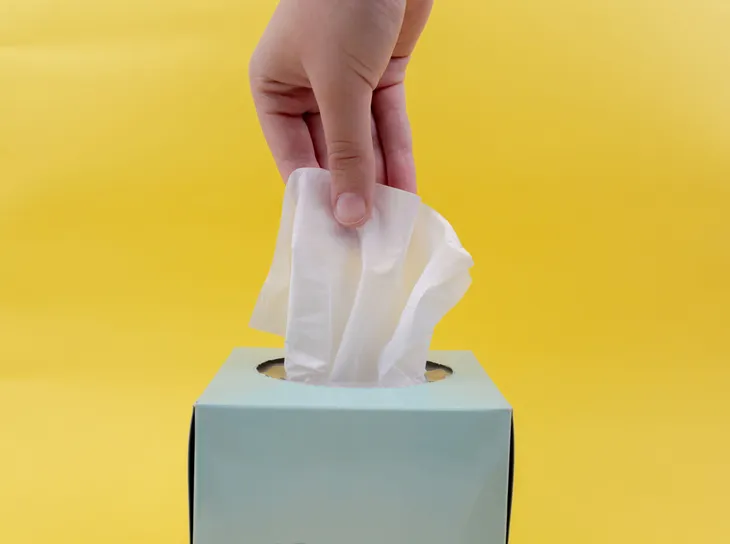Admit it; when you blow your nose you take a little peek, don’t you? It’s healthy to examine what’s left behind in your tissue because it can be a good indication of your overall health. Not only the color, but also the texture of your mucus (or snot, if you prefer) can tell you if you’re coming down with a common cold, a fungal sinus infection, or even worse…
Green or Yellow
Not to disagree with North America’s favorite frog when he sang, “It’s not easy being green,” but I’m sorry Kermit, green or yellow-tinged snot is not always a sign of an infection. Common belief tells us that green mucus always indicates a bacterial infection—while yellow is the sure sign of a viral infection. However, otolaryngology (or ear, nose, throat specialty physicians) researchers at the University of Mississippi Medical Center, say that’s not always the case.
Several things can cause mucus to turn a lovely shade of green or yellow. Sure, a bacterial infection can turn your snot from clear to green, but so can inflammation and mucus quantity. If your nasal passages are inflamed and super congested, the telltale green or yellow tinge is a sign that your white blood cells have come to the rescue. As they fight to eradicate whatever ails you, dead white blood cells don’t turn mucus white—they turn it yellow or green. Plus, if you do have an infection or virus, you’ll also show related symptoms (i.e., sinus pain, congestion, and fever).
Reddish-Pink
Red or pink-tinged snot in your tissue after a good hard blow will often be a bit of a shocker. However, research by the Cleveland Clinic states that this blood-speckled hue typically indicates the presence of a few broken blood vessels inside the nose. So if you blow like a fog horn chances are you see red often after a few sturdy blows.
This is because you have ruptured blood vessels near the surface of your inner nasal passages—often close to the inside of the nostrils. Blood can also be drawn if the lining of your inner nose is too dry. So take it easy if your nose is dry or sore and blow gently to avoid any further damage. Remember, once a vessel is damaged, bleeding can recur every time the scab is dislodged with another powerful blow.
White or Milky
You’re likely a seasonal allergy sufferer if you see the presence of white or milky colored mucus in your tissue. Cloudy, milky snot is a common sign of allergies, or rather the dehydration and inflammation caused by an allergic reaction, according to research from WebMD.
When the inner nasal passages will become dehydrated and inflamed as mucus production and flow decreases due to allergies. As the inner nose lacks essential moisture for lubrication, the cells in nose hairs become inflamed and prone to injury, and snot turns whitish in color. Luckily, you can easily remedy a dry nose and encourage mucus production by administering a gentle saline spray to each nostril and by drinking lots of water to flush out allergens (i.e., pollen particles).
Black or Dark Brown
Of course, black or dark brown mucus is almost guaranteed if you inhale ash, coal, or smoke. However, when your tissue appears black, or black tinged, with no smoke or pollutants (i.e., beryllium) in sight, you may be left scratching your head over what exactly is up your nose.
Medical officers with the U.S. Centers for Disease Control and Prevention, claim that black-laced snot can often be the case with the presence of a chronic fungal sinus infection (i.e., mucormycosis and aspergillosis) or pneumonia. Think of fungus like microscopic bats, hanging upside down on the dead tissue of your inner nose. If you’re experiencing blocked or backed up mucus production, talk to your doctor. You may have a fungal infection due to a compromised immune system.
Dark Yellow or Gold
If you’ve recently inhaled or found mold spores growing in your home, you may have noticed a change in the color and consistency of your snot as well. Breathing in mold is normal. In fact, doctors of otolaryngology at the University of Mississippi Medical Center, reassure that the majority of us breathe in mold regularly, but are able to flush it out of the body via the throat and nose.
However, if mucus in your tissue begins to appear thick and dark yellow (or gold) with a sticky consistency that resembles peanut butter—it’s cause for concern. Make an immediate appointment with your doctor as you may be suffering from an infection if mold spores become trapped in your nose and you are suffering an allergic response.
Clear or See-Through
Were you aware that the average healthy person produces roughly 4 or more cups of snot each day? One very important factor to keep in mind is that the mucus of healthy individuals is clear (or completely see-through) in color and thin in consistency.
Even though it’s rather gross, snot has an essential and serious job to do, according to Dr. Spencer C. Payne, associate professor of rhinology and endoscopic sinus surgery at the University of Virginia, Charlottesville. The body needs adequate mucus production to keep the inner lining of the nose moist and clean. After all, it’s not that it dislodges and sweeps pollen, foreign particles (i.e., mold), pollutants, and viruses and bacteria out of the nose, as well as the mouth and throat.









